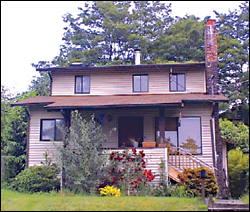Tan vinyl siding. A blue carpet that squished when you walked on it. Plumbing fashioned with coat hangers and a Pepsi can. Hardly the stuff dream houses are made of. Yet that’s what my fixer-upper became after I bought it four years ago, when the market was merely superheated. Today it’s even hotter, so maybe prospective buyers can learn some cautionary lessons from my experience. Let me start with hard-earned lesson number one: Triple your original time and cost estimates on the project.
Back in 2000, it was only a desire not to fritter away a dead grandma’s bequest on a South American beach that led me to purchase a home. Hardly a homebody, my intent was to first renovate the four-bedroom, two-bath 1912 Rainier Valley house that had burned down and been shoddily rebuilt twice, then to rent it out to subsidize my further travels to foreign lands. I was 31, single, and not interested in settling down.
The house had other plans for me. A dangerously dilapidated wooden deck sprawled over the entire backyard. Grimy linoleum in the kitchen curled up in the corners like dried melon rind. When I moved the stove, a long-dead rodent stared up at me with glazed, flattened eyeballs. Other people remove their ugly carpeting to discover beautiful wood floors underneath. Once my rotted carpet was peeled away (and the clouds of gnats and blue mold trapped underneath had cleared the air), I found charred fir from the early 1900s and plywood circa 1973—neither remotely suitable for refinishing.
Yet it had “potential”—the most dangerous word in the English language, as I would soon discover.
I imagined how charming the kitchen would look with a paint job, new cabinets, and the removal of a ridiculous coffee bar. I dreamed of living with other adults, commune-style, and of the fabulous dinner parties I’d host. There was even a brick fireplace, plus a sliding glass door that opened out onto the backyard. So I scrapped my travel plans and set up house with two friends.
“Set up house” was a euphemism: The bathrooms had been ripped out save for one dingy toilet, and the kitchen appliances and cabinets were in, alright—still in boxes stacked in the living room. We three called it “camping with electricity,” and we showered and cooked at another friend’s house for the first three months.
Meanwhile, I dreamed of white oak floors and knocking out an extra window in the kitchen. A maniacal aesthetic emerged in me. I painted each wall in the house a different hue. My mother and I planted a brilliant, colorful garden. Ideas for new household projects would come to me in the middle of the night, and I became Home Depot’s best customer between midnight and 6 a.m. (The store also offers awesome free classes on painting, tiling, and the like.) Even if the baseboard and trim were never quite finished, who cares when you have hot and cold running water and a claw-foot bathtub with a skylight overhead?
Most of the heavy work was done by contractors, who tramped in and out trailing messes and broken deadlines. Otherwise, I’d try to scrimp and save by doing what I could on my own. I didn’t know much about tools, though, which can be dangerous. A friend once found me dazed and bleeding from the forehead after bonking myself with a crowbar while trying to pry up stubborn floor boards. And I confess I cried and wrapped myself around a bottle of scotch before I could force myself to finish tiling my bathroom, which took four days longer than expected because the floor wasn’t level.
Every time an old layer of the house was removed, new problems sprang out of the woodwork—sometimes literally, like when a giant rat popped out of one of the crawl spaces. My bargain house was no longer such a bargain. I had to take out a $50,000 remodeling loan, which upped my monthly payments dramatically just as my temping gig ended and the dot-com boom busted, drying up my job possibilities.
My original two friends/tenants eventually moved on, leading to a seemingly endless parade of new housemates. Some were terrific; others I had to force out, such as the young girl who began receiving letters stamped “From Shelton Prison.” The correspondent was an ex-boyfriend who, she assured me, had “changed” and would be released in a month. New scenarios began to run through my head—would it be necessary to rob a bank to pay the bank?
The beginning of the end was an $800 water bill I got a year ago, four times higher than normal, the cause of which I never determined. My next-door neighbor’s sewer pipe burst to the tune of several thousand dollars, and I had nightmares that the same thing would happen to me. My freelance writing and teaching didn’t cover the bills. I discovered a roommate fishing around in my clothes closet and sleeping in my bed when I wasn’t home.
I knew something had to give, but I couldn’t give up my house. Four months ago, I moved out and rented the whole place, which plunged me into yet another nightmare—that of the absentee landlord. If I hated dealing with problems when I lived there, having to solve them for someone else was worse. All that, and I still wasn’t collecting enough in rent to cover the entire mortgage. I couldn’t even afford to pay someone to mow the sloping hill of lawn, which is why I recently found myself staring perplexedly at a gas mower on the property and wondering how to start it.
So last month I finally put the house on the market. Let my distress become someone else’s opportunity, I figured. Let somebody else enjoy the sunny kitchen, cozy fireplace, and charming atmosphere.
It’s not like I’m looking to make a killing. The house—certainly much nicer now than it was four years ago—is listed at $315,000, cheap by Seattle standards. You can even view it on Coldwell Banker Bain’s Web site (www.cbbain.com, MLS number 24074872). I’m not making any false claims about the place. For me, it was the greatest challenge of my adult life, eventually assuming the weight of an anvil around my neck.
But, damn, I miss that place. Maybe that’s the lesson for any similarly financially stretched young Seattle home buyer: A fixer may break your heart (and possibly your bank account), but you never forget your first love.







